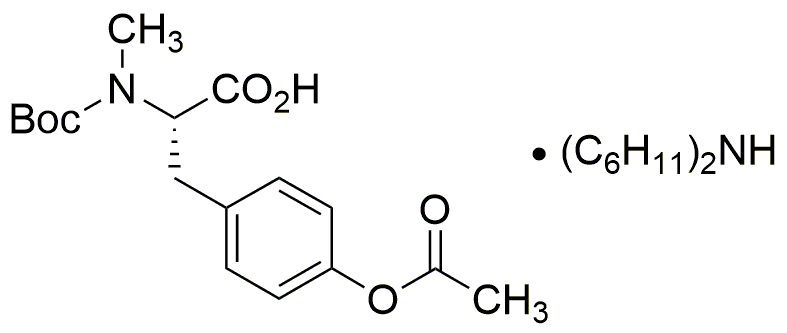Boc-N-methyl-O-acetyl-L-tyrosine dicyclohexylammonium salt is widely utilized in research focused on:
- Peptide Synthesis: This compound serves as a key building block in the synthesis of peptides, particularly in the pharmaceutical industry, where it helps in developing new drugs and therapeutic agents.
- Drug Development: Its unique properties enhance the solubility and stability of drug formulations, making it valuable in the development of oral and injectable medications.
- Biotechnology: Used in the production of biologics, this compound aids in the formulation of proteins and enzymes, crucial for various biotechnological applications.
- Research in Neuroscience: Its derivatives are studied for their potential effects on neurotransmitter systems, contributing to the understanding of neurological disorders.
- Cosmetic Formulations: The compound is explored for its potential in skin care products, where it may enhance the delivery of active ingredients, improving product efficacy.
General Information
Properties
Safety and Regulations
Applications
Boc-N-methyl-O-acetyl-L-tyrosine dicyclohexylammonium salt is widely utilized in research focused on:
- Peptide Synthesis: This compound serves as a key building block in the synthesis of peptides, particularly in the pharmaceutical industry, where it helps in developing new drugs and therapeutic agents.
- Drug Development: Its unique properties enhance the solubility and stability of drug formulations, making it valuable in the development of oral and injectable medications.
- Biotechnology: Used in the production of biologics, this compound aids in the formulation of proteins and enzymes, crucial for various biotechnological applications.
- Research in Neuroscience: Its derivatives are studied for their potential effects on neurotransmitter systems, contributing to the understanding of neurological disorders.
- Cosmetic Formulations: The compound is explored for its potential in skin care products, where it may enhance the delivery of active ingredients, improving product efficacy.
Documents
Safety Data Sheets (SDS)
The SDS provides comprehensive safety information on handling, storage, and disposal of the product.
Product Specification (PS)
The PS provides a comprehensive breakdown of the product’s properties, including chemical composition, physical state, purity, and storage requirements. It also details acceptable quality ranges and the product's intended applications.
Certificates of Analysis (COA)
Search for Certificates of Analysis (COA) by entering the products Lot Number. Lot and Batch Numbers can be found on a product’s label following the words ‘Lot’ or ‘Batch’.
Numéro de catalogue
Numéro de lot/série
Certificates Of Origin (COO)
This COO confirms the country where the product was manufactured, and also details the materials and components used in it and whether it is derived from natural, synthetic, or other specific sources. This certificate may be required for customs, trade, and regulatory compliance.
Numéro de catalogue
Numéro de lot/série
Safety Data Sheets (SDS)
The SDS provides comprehensive safety information on handling, storage, and disposal of the product.
DownloadProduct Specification (PS)
The PS provides a comprehensive breakdown of the product’s properties, including chemical composition, physical state, purity, and storage requirements. It also details acceptable quality ranges and the product's intended applications.
DownloadCertificates of Analysis (COA)
Search for Certificates of Analysis (COA) by entering the products Lot Number. Lot and Batch Numbers can be found on a product’s label following the words ‘Lot’ or ‘Batch’.
Numéro de catalogue
Numéro de lot/série
Certificates Of Origin (COO)
This COO confirms the country where the product was manufactured, and also details the materials and components used in it and whether it is derived from natural, synthetic, or other specific sources. This certificate may be required for customs, trade, and regulatory compliance.

